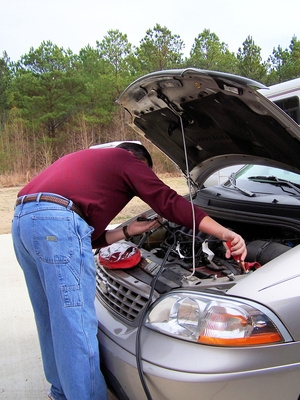
Mitsubishi automobiles use an alternator to recharge the battery and provide electrical power to the engine and accessories. This alternating generator can wear out, leading to low or no electrical power or flickering lights. The alternators on modern Mitsubishi cars and trucks use serpentine belt systems, making removal much easier than the previous single belt system. The average backyard mechanic can replace an alternator in a Mitsubishi in about thirty minutes.
Disconnect the battery by turning the positive terminal mounting bolt counter clockwise, using a 10 mm socket. Some older Mitsubishi models use larger bolts.
Press the tension pulley arm firmly until the serpentine belt loosens.
Quickly pull the loose belt out from underneath the idle pulley wheel, located at the top of the motor.
Release the tension pulley arm and the belt becomes slack.
Remove the belt from the alternator's pulley wheel by sliding it around the edge.
Remove the wiring harness adapter plug from the alternator by pressing the small catch on it's underside and pulling it directly out of the socket.
Remove the primary positive terminal by turning the mounting bolt counter clockwise and sliding the wire's ring terminal from the post.
Turn the alternator's mounting bolts counter clockwise and slide them out, using the socket wrench.
Remove the alternator by pulling it free of the mounting arms.
Replace the unit, and slide it back into the mounting bracket arms. Match the bolt holes up to the correct orientation.
Press the mounting bolts in and turn them clockwise until very snug.
Replace the primary electrical wire by pushing the ring terminal over the alternator's post and securing the bolt clockwise.
Replace the wiring harness adapter by pressing it into the socket until the catch clicks.
Wrap the drive belt back over the alternator's pulley wheel.
Press the tension pulley arm and slide the belt back underneath the idle pulley wheel.
Release the tension pulley arm and the belt tightens to the proper tension.
Reconnect the battery's positive terminal and secure it tightly by turning the terminal bolt clockwise with the socket wrench.